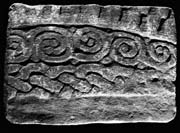Select a site alphabetically from the choices shown in the box below. Alternatively, browse sculptural examples using the Forward/Back buttons.
Chapters for this volume, along with copies of original in-text images, are available here.
Object type: Part of hogback
Measurements: L. 69.8 cm (27.5 in); W. 20.3 > 19.7 cm (8 > 7.75 in); D. 50.8 > 48.3 cm (20 > 19 in)
Stone type: Coarse-grained (with a few quartzite pebbles up to 5 mm), feldspathic, yellow (10YR 7/8) grit; see no. 1.
Plate numbers in printed volume: 241-245
Corpus volume reference: Vol 3 p. 87
(There may be more views or larger images available for this item. Click on the thumbnail image to view.)
A (long): Part of the lower two rows of tegulae survive (G.I., fig. 7, 2c). The eaves are recessed and the vertical sides carry a horizontal run of spiral scroll with pellet infills, or rudimentary berry bunches, above a horizontal strip of three-strand plain plait, using broad, flat strands.
C (long): Identical to face A, except that the plain plait and the lower part of the spiral scroll have been obliterated.
B, D, and E: Recut.
This type h hogback closely resembles others in the class (Lang 1984a, 101). Its scrolls are late Anglian survivals on a form of monument typical of the Anglo-Scandinavian period. Cramp has suggested that this kind of scroll derives from Cumbrian versions rather than ninth-century Yorkshire ones like those at Ilkley, West Riding (Cramp 1984, I, 88). The distribution of type h hogbacks is very unlocalized.



